
You have to wonder, what the heck are people thinking when they buy this stuff? More importantly, what are the people who make it thinking? Inquiring minds want to know. Well, OK, sick, depraved minds want to know. Let's proceed, shall we?

TREET (Armour
Star brand): The 'luncheon loaf' with the 'Virginia baked ham taste' creates
a vivid image of a lump of this stuff in your oven, studded with peppercorns
for a festive touch, baking away as the main course for some bizarre ritualistic
dinner. But what's so special about Virginia baked ham taste as opposed
to, say, North Dakota baked ham taste?
Of course, the back of every can has a recipe - pictured is 'Cheesy Treet
Breakfast Muffins.' Can't you picture people lining up for blocks for these?
What's
In It: Mechanically separated chicken, pork, water,
salt, corn syrup, baked Virginia ham seasoning (sugar, salt, brown sugar,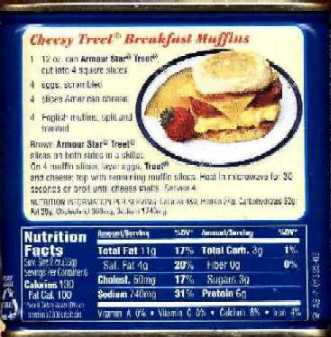 soybean oil, hydrolyzed corn, soy and wheat proteins, barley malt flour),
natural flavorings, smoke flavoring, sugar, food starch-modified, sodium
tripolyphosphate, sodium erythorbate, sodium nitrite.
soybean oil, hydrolyzed corn, soy and wheat proteins, barley malt flour),
natural flavorings, smoke flavoring, sugar, food starch-modified, sodium
tripolyphosphate, sodium erythorbate, sodium nitrite.
What That Means: Mechanically separated chicken (or poultry of any kind) is a paste-like product made by forcing crushed bone and 'edible tissue' through a sieve to separate the bone from the tissue. Mechanically separated poultry has been used in food products since 1969 after the National Academy of Sciences found it safe for use. The U.S. Department of Agriculture's rule on mechanically separated poultry says it is safe to use without restrictions, but must be labeled as 'mechanically separated' in the ingredient statement. As to what part of the pig ends up in Treet, you're just going to have to use your imagination.
Is It Good For You? In a word, Sorta'. Sliced into six equal slabs, each one considered a serving, gives you a good head start on a high fat, high sodium diet, with 17 percent of your total daily fat needs and 31 percent of your total sodium needs in just one slice (wow!). There is protein, to be sure, and some carbohydrates from all the sugars used as flavorings, but little other redeeming nutritional value. But you already knew that ... didn't you?
Most Bizarre Recipe: Tangy Kabobs. Take a can of Treet cut into 1-inch cubes, cherry tomatoes, green pepper chunks, onions chunks and mushrooms, skewered and lightly grilled as they are brushed with sweet and sour sauce. Neighborhood barbecues will never be the same after you serve these babies at the next cookout.
Nutrition per 2 oz. serving: Calories 130; Fat 11g; Cholesterol 50mg; Sodium 740mg; Carbohydrates 3g; Fiber 0g; Protein 6g.

POTTED MEAT FOOD PRODUCT (Armour Star brand): Thank God for truth-in-labeling laws. At least they have to call this stuff a 'food product' as opposed to straight-up food, although the difference is lost on us. One of the mainstays of the culinarily-challenged because of its ability to be shaped into numerous imitations of real food, from hamburger patties to hot dogs and even buffalo chicken wings. If that's too much of a stretch for you, the 'serving suggestion' includes using it as a sandwich spread and on crackers garnished with an olive, tomato, what appears to be cucumber and the ever popular hard cheese slice. Let the feast begin!
What's In It: Mechanically separated chicken, beef tripe, partially defatted cooked beef fatty tissue, beef hearts, water, partially defatted cooked pork fatty tissue, salt, mustard, natural flavorings, dried garlic, vinegar, dextrose, sodium erythorbate, sodium nitrite.
What That
Means: Our old pal mechanically separated chicken
reappears, along with a few new additions. Tripe is the muscular lining
of a beef (cow for you city slickers) stomach. This gelatinous, honeycomb-like
membrane is tough to digest under any conditions, and usually has to be
cooked 12 hours or more for those bizarre few who eat it of their own free
will.
Partially defatted cooked beef and pork fatty tissue may seem like an oxymoron
at first, but it does make a horrible kind of sense. There's a certain
amount of animal tissue that holds fat. This 'byproduct tissue' has the
fat rendered out of it, or removed, via emulsion. The byproduct tissue
(which by law has to include at least 12 percent 'normal' meat) is ground
or chopped up really, really small, then mixed with water, salt and some
other things we won't mention here, which causes the fat to become encapsulated
and form the goo-like emulsion. The resultant partially defatted fatty
tissue is then cooked and added as the third and sixth ingredients in Armour
Potted Meat Food Product. Waste not, want not, right?
Is It Good For You? You have to ask? Sheesh. The 3-ounce can constitutes one serving. You do get a respectable amount of protein, 11 grams, but that is canceled out, or balanced out, by the total fat (14 percent of your daily need), sodium (31 percent!) and cholesterol (25 percent). All of which makes us reasonably certain that potted meat food product is not regularly served in hospital cardiac care wards, unless they are covertly trying to drum up more business.
Most Bizarre Recipe: Tangy Spread. Mix two cans of Armour Potted Meat Food Product with some horseradish, your favorite mustard and a brick of cream cheese (softened, of course); chill thoroughly. Serve on bread or crackers and call it by some fancy-sounding foreign name to fool your friends or freak out your enemies.
Nutrition per 3 oz. serving: Calories 130; Fat 9g; Cholesterol 75mg; Sodium 750mg; Carbohydrates 0g; Fiber 0g; Protein 11g.

VIENNA SAUSAGE (Armour Star brand): You get 7 of these odd little things in a can, which is 2.5 servings according to the Armour Star folks. But in this case, can 7 really be considered a lucky number? It does win the prize for having the greatest variety of 'meat products' in it - chicken, beef and pork - but we're not sure if it rates the cosmopolitan sounding title of 'Vienna' for doing so, even if it does come in a bewildering number of varieties (9 at last count, including Barbecue, Cajun, Chicken, Hot and Spicy, Honey Mustard, Jalapeno, Lite, Original and Smoked).
What's In It: (Original variety) Mechanically separated chicken, water, beef, pork, salt, corn syrup, mustard, spices, natural flavorings, dried garlic, sodium nitrite.
What That
Means: The ever-popular mechanically separated chicken
is again the lead ingredient in this, a perennial favorite of campers,
fishermen and people who have a fixation on meaty-appearing tubular thingies.
We're not sure what parts of the cow and pig end up in these pasty-looking
treats. Probably best not to wonder too much.
The front label talks about 'beef stock' but that is not listed in the
ingredients. We're guessing that the 'stock' is the water combined with
whatever beef juices meld with it in the can. Armour's version of cold
fusion, perhaps?
Is It Good For You? Absolutely. No ... really. We're serious here! As long as you don't lick your fingers afterwards, you'll be fine. And don't ask us why we just wrote that.
Most Bizarre Recipe: Viennese Rarebit. A jar of processed cheese spread, some milk, a can of Vienna sausage drained and sliced thin and a little grated onion. After you heat and blend until smooth, serve over cooked rice. The only thing rare about this creation is probably the number of people who have actually made and consumed it.
Nutrition per 1.9 oz. serving: Calories 150; Fat 14g; Cholesterol 50mg; Sodium 430mg; Carbohydrates 0g; Fiber 0g; Protein 5g.

SPAM (Hormel brand):
The revered granddaddy of all canned meat delicacies, Spam 'luncheon
meat' (as they insist on calling it) has been around since 1937. Originally
called Hormel Spiced Ham, some extremely clever person took the first two
letters from Spiced and the last two letters from Ham to come up with a
cultural icon, and a fairly enduring one at that. Just ask any World War
II, Korean War, Vietnam War, Gulf War or Iraq War veteran.
And all of those rumors about using air-drops of Spam as part of a psychological
warfare campaign against the Taliban are simply not true. But when you
consider that more than 5 billion cans have been sold ...
What's In
It: Pork with ham, salt, water, modified potato starch,
sugar, sodium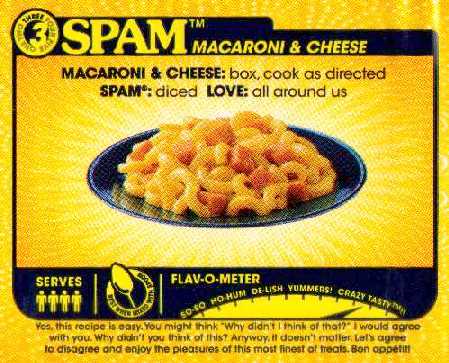 nitrite.
nitrite.
What That
Means: Since pork and ham both come from the same
animal, a little explanation is in order. The pork comes for the shoulder
part of the pig, one of the big muscle areas, and the ham comes from ...
a little further back. The shoulder meat is added raw and the ham portion
is already pre-cooked before the entire concoction gets cooked and inserted
into the newly-redesigned can. In fact, the label used to say 'pork shoulder
meat with ham,' but that was judged too confusing to consumers. Like that
really mattered.
On another note, the sheer flexibility of this 12 ounce pig-in-a-can makes
it a staple of the convenience store shelf. You can fry it, grill it, bake
it, broil it, steam it, stew it, microwave it, eat it cold right out of
the can ... the list, according to Hormel, is endless.
Also apparently endless is the varieties
of Spam that have appeared and will, we can only hope, keep appearing long into
the future. As of this writing we have an amazing
15
varieties in the traditional 12-ounce can:
Is It Good For You? Its creators certainly think so, judging by the dozens of recipes they have come up with for eating this stuff. But seriously, if you are on a high fat, high sodium, high cholesterol diet, this is the choice for you, for tradition's sake if nothing else. Each 2-ounce slice (six in a can) gives you 25 percent of your total fat needs for the day, along with 33 percent of the sodium and 13 percent of the cholesterol. There is protein, sure, but at 7 grams per serving, it's not packing it in like some of the other oddities here. Still, tradition can be a powerful influence on your buying/eating habits. B.F. Skinner was right, we can be trained.
Most Bizarre Recipe: Spam Cupcakes. For the cupcakes, grate a can of Spam and mix with 2 eggs, some oatmeal and milk. OK so far? For the glaze, you need some brown sugar and a little mustard, vinegar and water. Preheat your oven and fill the bottom two-thirds of each muffin tin with the Spam mixture, then spoon the glaze mixture over that. Bake until mixture is set. Meanwhile, prepare 4 cups of instant mashed potatoes. Remove cupcakes from oven. Top each cupcake with potatoes. Return muffin tin to oven. Broil until potatoes are lightly browned. Garnish with fresh chives. Serves 12. Sounds like an all-around crowd-pleaser to us!
Nutrition per 2 oz. serving: Calories 180; Fat 16g; Cholesterol 40mg; Sodium 790mg; Carbohydrates 1g; Fiber 0g; Protein 7g.

SPAM SPREAD (Hormel brand): An interesting follow-on product to Spam is the spread that also bears that proud name. So interesting that we're at a loss for words ...
What's In It: Pork, mechanically separated chicken, ham, salt, sugar, water, spices, sodium nitrite.
What That Means: Ground up pig parts apparently don't have the high-caliber 'spreadability factor' that Hormel wants, so it has to add ground up, shoved-through-a-sieve chicken parts to the mix. We asked the good folks at Hormel what parts of the pig were included, and they were a little vague. Not vague enough to be worrisome - this is Spam, after all, a canned meat icon.
Is It Good For You? Sure, if you like your Spam gooshie, or if you want to play the see-if-you-can-stick-a-spoonful-of-it-to-the-ceiling game (good for hours of fun and serious betting). They claim there are two servings in this dinky little 3-ounce can, but we found it to be closer to four good-sized spoonfuls of protein, with modest amounts of fat and cholesterol (18 and 13 percent of your daily need, respectively), and a pretty potent dose of sodium, almost as much as its more substantial cousin.
Most Bizarre Recipe: Cheese Ball. Fire up the electric mixer, toss the following into a bowl and whir away: a brick of softened cream cheese, a can of Spam spread, some shredded Swiss and cheddar cheeses, a little dried mustard and some sliced green onions. Roll the resultant goo into a ball, roll that in chopped, toasted pecans until covered, then wrap in plastic wrap and chill until firm, with a corpse-like appearance. Serve with assorted crackers and never - ever - answer the following question: Why is that cheese ball such a funny color?
Nutrition per 2 oz. serving: Calories 140; Fat 12g; Cholesterol 40mg; Sodium 570mg; Carbohydrates 1g; Fiber 0g; Protein 8g.

SPAM LITE (Hormel brand): Not content to stop with The Perfect Food, the good folks at Hormel had to make it The Perfect Food that is Now Better For You!
What's In It: Pork with ham, mechanically separated chicken, water, salt, modified potato starch, sugar, sodium phosphates, potassium chloride, sodium ascorbate, sodium nitrite.
What That Means: Relax, you Spam purists, it's still Spam. For the most part. The Hormel folks just, ummmm, added a few things. Like chicken, which has less fat than pork. And various and sundry chemicals to make the chicken taste like pork. Other than the chicken and the chemicals, it's still Spam! So quit whining and dig in.
Is It Good For You? Anything that says Lite on the label has to be good for you. Doesn't it? In relative terms, yes. This version of Spam does have less fat, true, and a few less calories. Tell you what, do a little experiment. Try living on nothing but Spam light for a month or so and then report back to us on whether you feel better. Or enlightened. Or just ready to put the pistol in your mouth and pull the trigger. It's all done in the name of science, we assure you.
Most Bizarre Recipe: Spam Quesadillas. Who knew that Spam could be so ... ethnic? You just dice your Spam Lite into lots o' lil' ole' cubes and warm them up in the skillet, while you meanwhile separate out some gen-u-ine Mexican flour tortillas. Dump a mound o' that hot sizzlin' Spam Lite in the center of a tortilla, slather on the Monterey Jack cheese, cover with another tortilla and then mound on the guacamole and/or salsa on top. Slice into wedges and, Ole!
Or, to quote the Spam zen master recipe creators: "Do not be fooled by the simplicity of this recipe. Yes, it easy to make, but the flavor is complicated and exotic. Like something that fills your senses and pulls at your heartstrings and then flies away, wanting to be chased. And you will chase it, oh yes, you will." Ummm ... right. Oh, Doctor? I think it's time to up the dosage on their medications!
Nutrition per 2 oz. serving: Calories 110; Fat 8g; Cholesterol 40mg; Sodium 580mg; Carbohydrates 1g; Fiber 0g; Protein 9g.
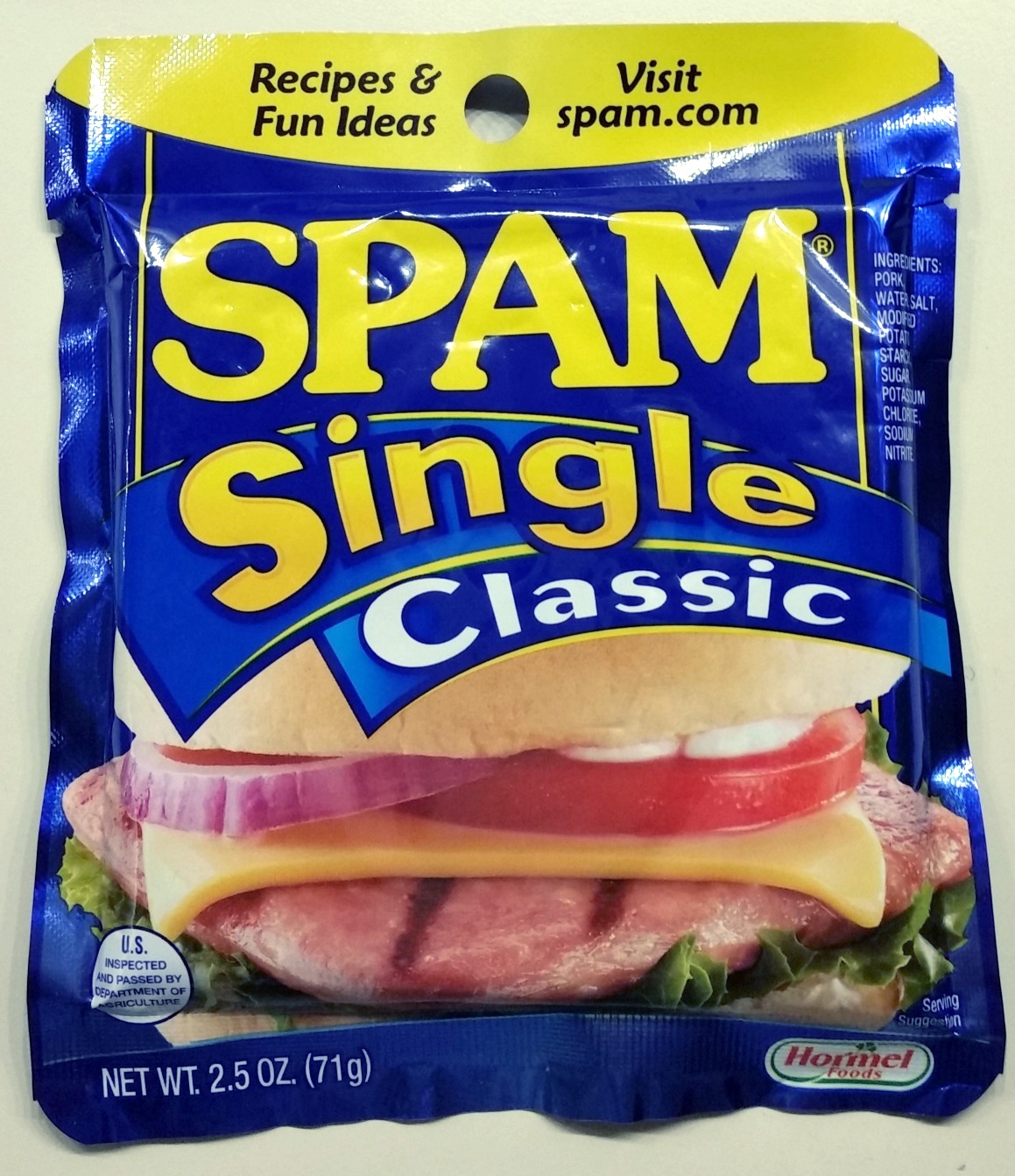
SPAM SINGLES (Hormel brand): The Perfect Food just got a little more amazing. Now you can can have your Spam anytime, anywhere, under any conditions, and for any reason! (Like you really needed one).
What's In It: Pork, water, modified potato starch, sugar, potassium chloride, sodium nitrite.
What That Means: Advances is packaging have now revolutionized the Spamsperiance, the joy all hard-core purists experience when eating Spam. And with a three-year shelf life, you can delay the experience almost as long as you want. Not that you'd really want to. Would you? Heckkkkkkkkkkkkkkkk no! Tear that foil pouch open right this instant and dive in!
Is It Good For You? In a word - absolutely. How can it not be? Now there is no excuse for not having a Spam slice with you at all times. Stuck in traffic during a bad commute? Spam slice! Flight delayed by a howling blizzard? No problem, Spam slice! Childbirth dragging on longer than you want it to? Spam slice! to make it allll better. Just get canned by your a-hole boss? Unwrap a Spam slice! and get used to that being your only meat for the week.
Most Bizarre Recipe: Spam Bagel. Wake up your eggs! shouts the Spammeister. Slap a Spam Single on top of your egg and cheese bagel to take it to the next level. Garnish with sliced strawberries (ohhhhhhhhhhhhhhh, fancy!) as per the Serving Suggestion.
Nutrition per 2.5 oz. serving: Calories 210, Fat 18g, Cholesterol 50mg, Sodium 830mg, Carbohydrates 2g, Fiber 0g, Protein 9g.
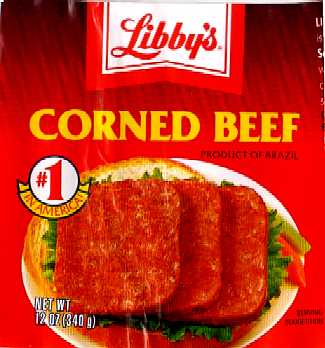
CORNED BEEF (Libby's brand): Here's a little historical trivia for you - there is no corn in corned beef. Corning is a form of preservation and has nothing to do with corn on the cob. The name comes from olden times before refrigeration, when meat was dry-cured in coarse 'corns' of salt which were rubbed into the meat to keep it from spoiling. Today brining - the use of salt water - has replaced the dry salt cure, but the name 'corned beef' is still used. Go figure. Corned beef is made from the less-tender cuts of beef like the brisket, rump and round, so it requires longgggg, moist cooking.
What's In It: Cooked beef, beef, water, salt, sugar, sodium nitrite.
What That
Means: Brazil. Rest easy, all of the beef is cooked
before it goes into this vaguely pyramidal shaped can that clings to the
traditional 'key' method of opening (see the detailed instructions at right).
It's just that some of the meat needs to be cooked longer. Way longer, hence the 'cooked' beef before the 'other' beef in the ingredients. Brazil.
It's those less-tender cuts of beef described above that are the culprit
... at least we hope that's the reason. Brazil. And canned corned beef
is further proof that anything can be made to appear edible if you
cook it long enough and add enough sugar, salt or other, more complex-sounding
chemicals. Did we mention that this stuff comes from Brazil?
hence the 'cooked' beef before the 'other' beef in the ingredients. Brazil.
It's those less-tender cuts of beef described above that are the culprit
... at least we hope that's the reason. Brazil. And canned corned beef
is further proof that anything can be made to appear edible if you
cook it long enough and add enough sugar, salt or other, more complex-sounding
chemicals. Did we mention that this stuff comes from Brazil?
Is It Good For You? As good as those wacky Brazilians, the corned beef kings of the universe (along with Argentina, of course), can make it. Seriously, though, one 2-ounce slice of this delicacy packs quite a punch, and is marginally less unhealthy in the sodium and cholesterol departments. You get a hefty 15 grams of protein per slice, but no carbohydrates or fiber (darn); total fat (11 percent of the daily need) and sodium (20 percent) are less than some of the other 'foods' discussed here. Woo-hoo!
Most Bizarre
Recipe: Creamy Corned Beef with Toast. Dice
about half a can of corned beef and mix with hot white sauce, spoon that
over four slices of toast, layer a sliced hard-boiled egg on top and add
(what the heck else?) parsley to top it off.
Someday, someone in the canned meat industry will be able to explain their
fascination with 'creaming' a canned cow, as opposed to simply gagging
it down. And by the way, have you ever tried to dice corned beef?
Not a task for those who aren't completely confident about their skills
with long, sharp knives or small power tools.
Nutrition per 2 oz. serving: Calories 120; Fat 7g; Cholesterol 50mg; Sodium 490mg; Carbohydrates 0g; Fiber 0g; Protein 15g.
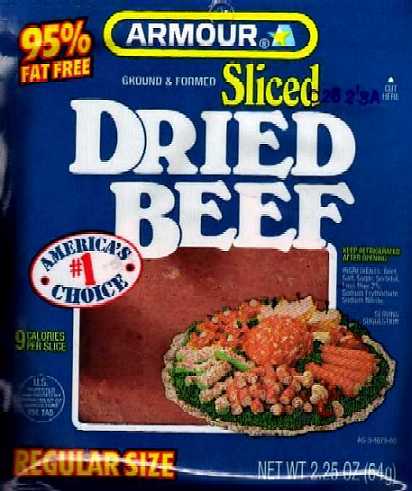
DRIED BEEF (Armour Star brand): This ain't your great-grandma's dried beef. This is a 21st century treat. Chopped, pressed, formed and then sliced very, very thin, so it vaguely resembles something you'd see in a deli - but that's where the similarity ends. And shame on Armour Star for doing away with the nifty glass jar that served generations of small children as their first real drinking glass. This new laminated plastic/metallic film packet has got to go. You just don't mess with tradition.
What's In It: Beef, salt, sugar, sorbitol, sodium erythorbate, sodium nitrite.
What That Means: Beef is the main ingredient, but salt is the overwhelming taste of these paper-thin rounds of meat. Not just lick-your-lips-from-too-much-sweating salt, or even ocean-waves-in-the-face salt, but a salty taste that will cause an instant pucker as your whole mouth contracts inward. Armour Star is unclear about exactly what parts of the cow end up in this heavily-processed product, which is vaguely disturbing. If God had intended cows to be made into dried beef, he would have made them wayyyyyy thinner and rounder, right?
Is It Good For You: Sure ... as long as you run it through the washing machine first to get rid of all the salt. Just kidding. Sort of. Seven slices (one serving), about 1 ounce of beef, has 57 percent of your daily sodium needs. No need to ask if that's healthy. Although a serving is surprisingly low in fat (2 percent) and cholesterol (8 percent), we think Armour Star is stretching things a bit when it calls this modern day suburban beef jerky 'ideal for today's health-conscious people.'
Most Bizarre
Recipe: Creamed Chipped Beef. Don't forget
to separate and rinse your dried beef slices before you cut them into bite
sized pieces. Combine some milk and a little corn starch in a bowl, melt
some butter in a pan and add the milk mixture. Stir until thickened. Add
Worcestershire sauce for taste and then dump in the dried beef bits and
heat thoroughly. Serve immediately over toast, rice, noodles or even pastry
shells (!) for breakfast, lunch or dinner.
This 'great American favorite every family loves' may have been popular
when any meat on the table was welcome, but the Great Depression
ended quite a few decades ago, Armour Star! We cannot believe that anyone
with any sense of human decency would still be touting this abomination.
U.S. military veterans have a rather telling name for this delightful dish
- Shit on a Shingle.
Nutrition per 1.1 oz. serving: Calories 60; Fat 1.5g; Cholesterol 25mg; Sodium 1,370mg; Carbohydrates 2g; Fiber 0g; Protein 8g.

CHICKEN SPREAD (Underwood brand): From the same folks who bring you that famous deviled ham (note the dude with the pitchfork on the label), we have here what can best be described as ... we'll be charitable and say 'interesting.' It may be 'made with only white meat,' but this chicken spread bears no resemblance to what you see trying to cross to the other side of the road, believe us. It more closely resembles something you would use to patch over a really big hole in the wall.
What's In It: Cooked chicken breast with rib meat, chicken broth, chicken skin, cooked chicken breast roll with rib meat and natural juices, chicken fat, hydrogenated vegetable oil (cottonseed, soybean), potato flour (potatoes with sodium bisulfite added to protect color, water), dried onion, modified corn starch, soy protein isolate, monosodium glutamate, spice and color, soy lecithin, citric acid, wheat starch, dextrose, onion powder, torula yeast, hydrolyzed soy protein, natural flavor, caramel color. Whew!
What That
Means: The sheer number of ingredients (25) should
be your first clue that this is chicken only in the loosest sense of the
word. The texture is very un-chicken-like. The Underwood company's fascination
with leaving the rib meat on the chicken breast and breast roll (?) has
a simple explanation - and as soon as we have it, we'll pass it right along
to you. There do seem to be an awful lot of parts of the chicken in there,
though. We never knew chicken skin could be considered white meat, and
as for chicken fat, well, it's definitely not white in color. The
USDA name for these last two items that sums it up pretty well - byproducts.
An interesting tidbit is that Underwood's deviled ham spread, which has
been around for eons, has only six ingredients. The pitchfork dude
has some chicken issues, it appears.
Is It Good For You? As long as you don't look at it, you bet. A serving size is one-fourth of a cup, but who could possibly stop there? True, it is healthier when it comes to the dreaded sodium (17 percent of your daily value) and cholesterol (10 percent), and even fat (11 percent), but the protein is somewhat lacking at only 8 grams per serving. That means you'd have to eat almost three of these quaint little cans to get your daily protein quota. Best get busy with that plastic teaspoon and start digging in, bubba.
Most Bizarre Recipe: Chicken Stuffed Celery. Take your basic brick of cream cheese (again, softened, of course), mix with a can of Underwood Chicken Spread, add a little curry powder and then stuff 16 of those 2-inch-long celery pieces you just beheaded, and stuff 'em but good! Sprinkle some paprika on top for color, bring to the next neighborhood soiree', and forever end your chances of getting invited back again. Just kidding ...
Nutrition per 2 oz. serving: Calories 110; Fat 7g; Cholesterol 30mg; Sodium 410mg; Carbohydrates 3g; Fiber 0g; Protein 8g.
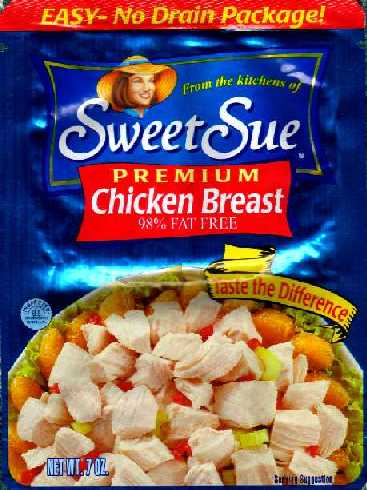
CHICKEN BREAST IN A BAG (Sweet Sue brand): What used to come in a can (or if it was really fancy, a glass jar) now comes in - a bag. Isn't technology wonderful? First it was fish in a bag (a.k.a. Charlie the Tuna) and now it's chicken. Or part of it, anyway. And this is not just any old bag. This is an easy-open-no-drain-take-it-anywhere-taste-the-difference bag! Pardon us while we recover from the thrill. But hey, staring at Sweet Sue's angelic face can give you a thrill any way you slice - or bag - it.
What's In It: Chicken breast, water, modified food starches, salt, sodium phosphate.
What That Means: The ingredients are pretty straightforward - chicken, water and a few other goodies. A cursory examination reveals chunks of something that closely resembles chicken, in a thin oily-looking liquid that likes to cling to the bag as you dump the chicken out. We're willing to give them the benefit of the doubt, but just this once. We will note that this is a vast improvement over the infamous Sweet Sue Canned Whole Chicken. You don't even want to know about that one. Trust us.
Is It Good For You? The jury's still out. It is chicken (we're pretty sure) but that begs the question - how long can this stuff stay in the bag and still be edible? There is no expiration or 'best if used by' date on the bag - excuse us, the Premium Chicken Breast Pouch - and no hints on storage. Sure, for you freshness freaks, it eliminates having to catch a chicken, behead it, gut it, pluck it and cook it yourself, but we're a little concerned about how long this fowl in a bag can remain digestible without a lot of chemical preservatives.
Most Bizarre Recipe: Chicken Fold-Overs. Mix a bag-o-bird with some salsa (chunky, naturally) and shredded cheddar cheese, drop a big blob of the resultant mixture onto a flour tortilla and fold it over ... the tortilla, you dimwit! Microwave until hot (duh) and then consume. Makes you feel like doing a Mexican hat dance, doesn't it? Ole!
Nutrition per 2 oz. serving: Calories 60; Fat 1g; Cholesterol 10mg; Sodium 320mg; Carbohydrates 0g; Fiber 0g; Protein 11g.
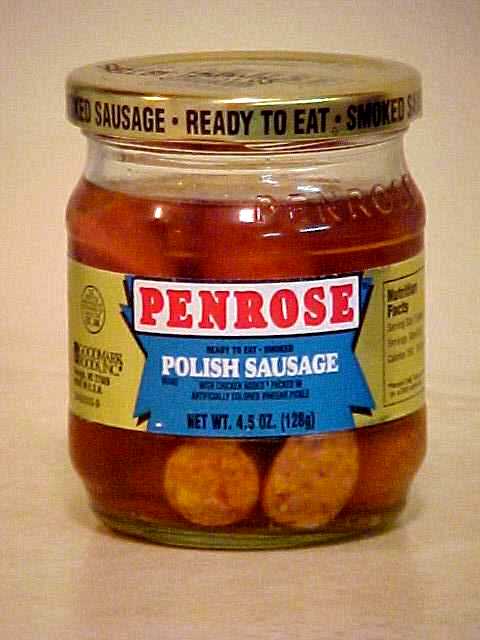
POLISH SAUSAGE (Penrose brand): The initial impression is that these are Vienna sausage on steroids, with their bright red color and jaunty angled cuts on the ends. Maybe it's because the same people make the world-famous Slim Jim snack, which has, despite its appearance, almost the exact same ingredients as these 'sausages.' Maybe it's because of something else entirely. You have been warned. And yes, this is a photo of the actual product instead of a scan of the label, because those metallized labels are just too darned hard to remove!
What's In It: Beef, beef collagen, water, mechanically separated chicken, salt, flavorings, soy protein concentrate, hydrolyzed soy protein, paprika, dextrose, paprika extractives, sodium erythorbate, sodium nitrite; packed in a solution of vinegar, salt, red 40.
What That
Means: We're sure that the USDA has some kind of official
guideline for what constitutes Polish sausage. We're also pretty sure that
the definition doesn't include chicken puree as part of it. And we're even
more sure that the folks at Goodmark Foods paid scant attention to that
when they cooked up these smoky-backroom-all-beer-a-quarter-no-leaning-on-the-pool-table
saloon staples (along with pickled eggs, of course, but that's another
page for another day).
The beef and mechanically separated chicken seem to need a lot of help
to hold things together in a sausage shape, though. That's where the beef
collagen and soy protein come in. Collagen is the 'connective tissue' that
helps hold muscles and bones together so cows don't just lie there and
flop around spastically. If you cook it long enough, it turns into gelatin,
but in this case it is used as the 'casing' for the 'Polish sausage.'
Is It Good
For You? The first step is getting past the funny-looking
'stuff' on the underside of the jar lid. And just ignore those little bits
of red 'stuff' floating on top of the pickling water, too. You'll have
to try harder to ignore the lumps of white 'stuff' in each sausage segment.
Don't forget to try and ignore the crunchy sounds they make as you eat
them, and wonder if that is merely bits of the spices or ... something
else. Just think of it as part of the 1.6 grams of protein you get with
every
delicious piece.
We suggest using a fork to spear your first victim, or you can impress
your date with how macho you are by plucking one out with your fingers.
Five of these little guys (equivalent to about 1 1/2 hot dogs) give you
36 percent of your daily sodium need and 19 percent of the fat, but a mere
7 percent of the cholesterol. Thank God for small favors, right? The paprika
extractives do give them a little zip, and there's nothing like red dye
40 to give your canned meat products that glow in the dark luster.
Most Bizarre Recipe: None to date. A worldwide search has turned up no practical suggestions, because unlike just about every other epicurean delight on this page, these little guys are meant to go solo, right out of the jar. Just hope that the lights are really, really dim wherever it is you decide you're ready for one of these. And then, as the flyboys like to say, it's 'Bombs away!'
Nutrition per 2 oz. serving: Calories 150; Fat 12g; Cholesterol 20mg; Sodium 870mg; Carbohydrates 1g; Fiber 1g; Protein 8g.
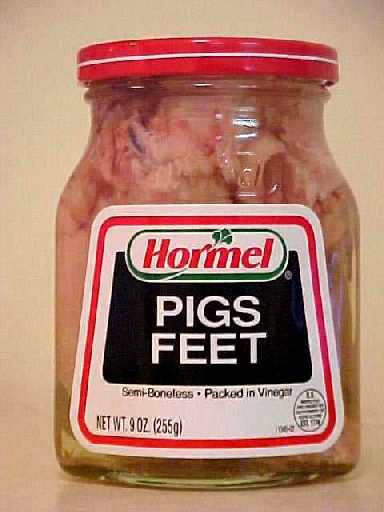
PIGS
FEET (Hormel brand): The way only Hormel can make
them, semi-boneless and packed in vinegar as a proud part of their Pickled
Products Division! Once you get past the fact that this 'food' looks like
something you'd see on a dusty, forgotten shelf in the biology lab - or
was it in the special effects storage room for the low-budget horror movies?
- the 9-ounce jar can make quite an interesting conversation piece on your
coffee table. We're guessing that most conversations would start out something
like, 'What the #$!&*) is
that $#!~*& looking #*&($*!*%~
on the table?,' or words to that effect.
What's In It: Pork feet (cured with water, sodium nitrite and sodium erythorbate), vinegar, salt and ascorbic acid.
What That Means: What it means is, Hormel lets nothing go to waste on its killing room floors. As you can see from the close-up photo of the contents, this is one canned meat label that very definitely tells it like it is. You get pigs feet and nothing but pure, almost-unadulterated pigs feet - about 4.5 servings per jar, to be exact. Is this a great country, or what? Where else could you chop the feet off some cute little pigs (we have to wonder at what point in the butchering process that occurs), stick them in a clear glass jar, slap on a plain-Jane label and have people pay you money for the privilege of scarfing them down?
Is It Good For You? You're not seriously wondering that ... are you? (sound of violent gagging at the mere thought).
Most Bizarre Recipe: None. Because no one in their right mind would eat these.
Nutrition per 2 oz. serving: Calories 80; Fat 6g; Cholesterol 45mg; Sodium 590mg; Carbohydrates 0g; Fiber 0g; Protein 7g.

ROAST BEEF (Hormel brand): Let's see, we've discussed corned beef and dried beef, so why not go all the way and dive into a can of roast beef as well? On the other hand, why ask why? They have to parboil and steam roast this stuff (for an indeterminate period) to make it soft enough to eat, so that should be your first clue that what's inside will be a real eating adventure. At least it has gravy - and as the canned meat conglomerates know all too well, you can make almost anything look appealing with lots of gravy.
What's In It: Cooked beef, water, tomato puree, corn starch, salt, wheat flour, onion, white pepper, caramel coloring.
What That
Means: What it means, pardner, is that prime cuts
of beef don't require a lot of cooking and chemicals to make them tender
and tasty. Those conditions don't apply to what is in these cans. Any more
questions?
On a completely unrelated note, we have a minor quibble with the Hormel
folks. The can label says the net weight is 12 ounces, or 340 grams (give
or take). Each serving is 131 grams, and there are 'about' 2.5 servings
per can. That's 327.5 grams, or 11.5 ounces. Where's the missing seven-tenths
of an ounce? Who does the math for these labels, a third grade dropout?
Not that we're complaining or anything ...
Is It Good For You? If you want protein, and lots of it, this is the clear choice for you - half a cup packs in a whopping 25 grams of the stuff, or 47 percent of your daily need. It doesn't get any heftier than that! The gravy, such as it is, is a nice touch, but the Brazil factor is enough to give us pause before stocking up on these goodies in anticipation of the next disaster/terrorist attack/nuclear war. But don't let that stop you from indulging.
Most Bizarre Recipe: Beef and Veggies. 'Prepare frozen vegetables. Mix with roast beef and heat.' Nine little words, with no clue as to the horror that lies within. We have to wonder what gyrations the photographer has to go through to make things like this look so darned good in those miniscule 'serving suggestion' photos - in this case it's a regular modern art masterpiece. The beef is brown, succulent, nicely dappled with rich brown gravy; the vegetables are crisp-appearing splashes of orange and bright green. And your face as you choke this down is ... we'll just skip that vivid image.
Nutrition per 4.7 oz. serving: Calories 150; Fat 4g; Cholesterol 75mg; Sodium 640mg; Carbohydrates 3g; Fiber 0g; Protein 25g.
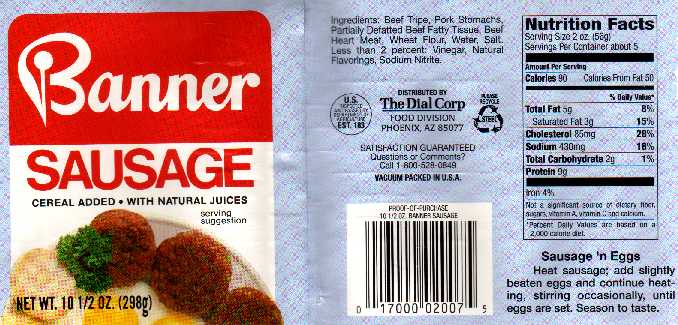
SAUSAGE (Banner/Dial brand): Just when you thought things couldn't possibly get any worse, you stumble across something like this at the grocery store. Stumble is probably the right word, since the can will be laying in the aisle where the last person who was brave enough to even pick it up dropped it and ran like hell after glancing at the ingredients.
What's In It: Beef tripe, pork stomach, partially defatted beef fatty tissue, beef heart meat, wheat flour, water, salt, vinegar, natural flavorings, sodium nitrite.
What That Means: Take a look at those ingredients again. Notice anything missing? Like meat, perhaps? What do we have here besides assorted stomachs, heart parts (couldn't even be bothered to include the whole thing!) and the infamous partially defatted fatty tissue? Nada. Zilch. Zip. Naught. Serving this to homeless people at a shelter would probably land you in court for cruel and unusual punishment.
Is It Good For You? It's probably better for you than walking through a minefield blindfolded. Your first clue should be the label - anything that has to have cereal added to it is a red flag. And as for the 'natural juices' it talks about, we've got, umm ... beef stomach lining juice, pork stomach juice, beef heart juice and whatever fluid partially defatted tissue exudes. Natural? Yes, barely. But edible? Seriously, you'd probably be better off just skipping the 'sausage' part of the ingredients and going straight to the wheat flour, etc. It's hard to screw up flour, water and salt, but the Banner folks have made a very determined effort at that.
Most Bizarre Recipe: We'll ignore the most merciful one, not buying it, and go to Sausage 'n Eggs. Heat sausage, add slightly beaten eggs and continue heating, stirring occasionally, until eggs are set. Season to taste. Vomit daintily into trash can after you dump this concoction in first. (OK, we added that last sentence, but it could happen, right?)
Nutrition per 2 oz. serving: Calories 90; Fat 5g; Cholesterol 85mg; Sodium 430mg; Carbohydrates 2g; Fiber 0g; Protein 9g.
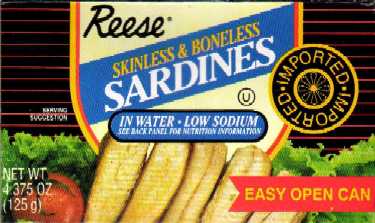
SARDINES (Reese brand, imported, in a cardboard box, even!): History shows us that back in the '20s and '30s, sardines were a staple in the American pantry. John Steinbeck immortalized the enormous Pacific sardine catches in his novel Cannery Row. My, how far this mighty though very small culinary icon has fallen, partly because the sardine industry crashed due to over fishing. Now you can find sardines, if your store stocks them at all, jammed in with the potted meat food product and tuna-in-a-bag. Hardly fitting treatment for such a nutritionally-potent and compact culinary treat.
What's In It: Sardines, water.
What That Means: The fact that these little guys are boneless and skinless takes some of the adventure out of the eating experience, to be sure, but it also allows you to savor the full-bodied flavor of ... fish ... fish ... and nothing but the fish. This is a top-of-the-line canned fish eating experience. And if you want a 100 percent natural treat, this is the clear choice. Unless, of course, you're worried about what they ate right before they got scooped up off the coast of ... Morocco (when was that last big oil tanker spill?).
Is It Good
For You? Sure, if you like little chunks of something
that might be fish. At least it looks like it used to be fish. Seriously,
though, a serving of these little guys (one entire can, about 6 or so thumb-sized
filets and miscellaneous bits) gets you well on your way to meeting your
daily protein needs, with 22 grams of the stuff; cholesterol (11 percent
of your daily need), sodium (2 percent) and fat (7 percent) are surprisingly
low, and there is some calcium (6 percent). Remember, though, these sardines
are packed in water. Get the ones packed in olive oil and you're
heading for a coronary meltdown in a hurry. You're better off sticking
with the ones packed in mustard, tomato sauce or one of the many other
variants.
And while we applaud the Reese's people for trying to use every available
space on their packages for marketing, somehow we don't think they're going
to make many sales by touting these other 'fish items' on the back of the
sardine box: Squid Pieces, Octopus and Kippered Snacks. Anyone for Filet
of Mackerel or Baby Clams?
Most Bizarre Recipe: Appetizer Tray. Arrange sardine filets artistically on a bed of fresh lettuce or other greens. Garnish with cherry tomatoes and serve. (We admit to having to improvise with this one). Sure to be a crowd-pleaser when unexpected company drops by! We'd recommend keeping several cans on hand for such 'social emergencies.'
Nutrition per 4.4 oz. serving: Calories 130; Fat 5g; Cholesterol 35mg; Sodium 50mg; Carbohydrates 0g; Fiber 0g; Protein 22g.

SLICED BEEF (Morton House brand): There is something to be said for plain old beef and gravy, as opposed to corned beef or roast beef and gravy. We're sure that someone, somewhere, has said something. They must have, right? Because this dish looks like it has been around since at least World War II, with its flat round can and singularly unimaginative ingredients. Only the true epicurean icons have this kind of staying power, rest assured.
What's In It: Water, cooked sliced beef-chopped and formed (beef, water, salt, sodium tripolyphosphate, torula yeast, hydrolyzed soy protein [with hydrogenated soy oil]), enriched wheat flour (wheat flour, niacin, reduced iron, thiamine mononitrate, riboflavin, folic acid), modified food starch, sugar, hydrolyzed soy protein (with cottonseed and soybean), torula yeast, flavorings, salt, caramel color.
What That Means: You'll notice that the words 'prime cut' appear nowhere on the label or in the ingredients, while words like soy, food starch and torula yeast keep cropping up, and the first word on the label is 'gravy.' The fact that this beef has to be chopped and formed before it is cooked and sliced means that, you guessed it, the slices are probably made up of lots of little bits of ... leftovers (no need to get too specifically gross). At least they include a lot of gravy, almost enough, in fact, to completely hide the meat and fool you into thinking you're getting something top grade. That couldn't be the real reason, could it? Nahhhhhhh.
Is It Good For You? We suppose so, if you're not on any kind of a diet. The calories are a clue - there are 210 per 1/2 cup serving, of which 150, or almost 72 percent, come from fat. So the only reason this tastes halfway decent (Hey, we're feeling charitable!) is because it's loaded with fat. Lots of fat. A whole 26 percent of your daily requirement in just one serving. And even though salt is the next to the last thing in the ingredients list, it still manages to give you a whopping 28 percent of your daily need. Good thing water is the first ingredient, it helps to dilute all the salt.
Most Bizarre Recipe: Heat and eat (stove top or microwave, your choice). That's all the guidance they give you for this nutritional marvel, although they do show it garnished with parsley (aaauughhhh!!!) and we have to wonder - what is that curly thingy on the side of the plate in the 'serving suggestion' photo?
Nutrition per 6 oz. serving: Calories 210; Fat 17g; Cholesterol 20mg; Sodium 680mg; Carbohydrates 8g; Fiber 0g; Protein 8g.
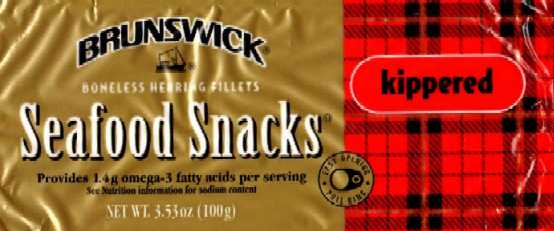
KIPPERED
HERRING (Brunswick brand): Our first question was,
Is that a name, or a state of mind? Turns out it's neither. You won't find
some poor slob named Kip crammed into this flat aluminum can with the rounded
ends and the enormous pull tab. 'Kippering' is another one of those obscure,
weird or just plain strange Old English terms, the origins of which are
long forgotten. In this case, it's 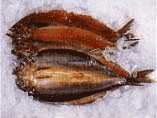 another means of preservation. The cute
little silvery herring's bellies are sliced open, their guts and spine
are yanked out, they get soaked
in salt water (feel the burn, guys!), and then they are smoked until they
turn a kind of golden color. It's apparently an important part of the process
to leave the back skin intact so you get the proper 'look' when your kipper
is spread out and presented for consumption.
another means of preservation. The cute
little silvery herring's bellies are sliced open, their guts and spine
are yanked out, they get soaked
in salt water (feel the burn, guys!), and then they are smoked until they
turn a kind of golden color. It's apparently an important part of the process
to leave the back skin intact so you get the proper 'look' when your kipper
is spread out and presented for consumption.
What's In It: Herring fillets, water, salt, natural smoke flavoring, sodium phosphate.
What That
Means: The English eat these for breakfast with brown
bread and butter, we are told. No wonder they are no longer a dominant
world power. This particular brand is a product of Canada, where they apparently
regard kippers as a snack food (at least that's what it says on the label),
but we think they are better suited for the tuck-it-away-for-the-next-apocalypse
role.
Obscure bit of trivia - 'Sardine' is a generic term applied to a number
of different species of small saltwater fish, which are prepared, cooked
and packed in a special way. Sardines are usually herring, scooped up and
canned before they could get big enough to rate 'kippering.'
Is It Good For You? It must be, because it says so, right on the label - 'Provides 1.4 g omega-3 fatty acids per serving.' Yum. Anyway, Kip and his friends do pack a respectable nutritional punch, with 18 grams of protein and 14 percent of your total daily fat needs. There is also the matter of sodium, 21 percent, and cholesterol, 18 percent, but hey, you're getting those fatty acid whatchmacallits, so quit complaining.
Most Bizarre Recipe: Serving Suggestions. Quoting right from the wrapper - 'Delicious on crackers, bread, toast, sandwich wraps or straight from the can. Add to your next dip or spread, or to your favorite fish cake recipe.' They sure do a lot with these kippered thingies up in Canada ... but we'd have to draw the line at including herring in a birthday cake. That is what they mean by fish cake, right? Imagine your next birthday party with a kippered herring cake and kippered herring sandwiches and kippered herring dip. Mmm-mmmmm good!
Nutrition per 3.4 oz. serving: Calories 160; Fat 9g; Cholesterol 55mg; Sodium 490mg; Carbohydrates 0g; Fiber 0g; Protein 18g.
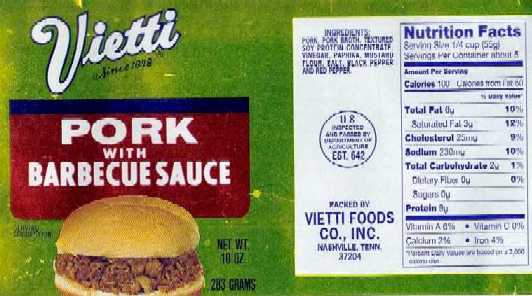
PORK with BARBECUE SAUCE (Vietti brand): We discuss other pork products here, to be sure - Spam is virtually all pork - but so far we've skipped over the socially-deprived phenomenon of barbecue in a can. Until now. No longer will you have to slave over an outdoor grill for hours (sometimes days) on end trying for that perfect, grilled-to-perfection barbecue. It's all right here in an easy-open pull top can. No muss, no fuss, no bother, and no taste, but hey, three out of four ain't bad! They do get points for the cool metallic label, though.
What's In It: Pork, pork broth, textured soy protein concentrate, vinegar, paprika, mustard flour, salt, black pepper, red pepper.
What's That Mean: Well, for starters, it means you can skip all the steps associated with 'real' barbecue. Just heat and eat. The ingredients do give a few clues as to what's inside, primarily the pork broth and the textured soy protein concentrate, which is another $5 word for 'filler material to bulk up the pathetic amount of real meat we put in here' - or words to that effect. As for the pork broth, the USDA apparently doesn't have a definition of what constitutes pork broth, so we're left with our imagination on that one. How many people does it take to wring a pig out to get all that broth, anyway?
Is It Good
For You: As far as saving you a lot of time, yes.
As far as taste and nutrition wise, well ... Nutritionally this stuff is
one of the more balanced 'foods,' with some carbohydrates in addition to
the expected protein and fats - and the fact that there are carbohydrates
in this at all is an indication that the soy protein additive is a major
'filler' material. There is a respectable amount of protein in the one-fourth
cup serving size, but the fact that 60 percent of the calories come from
fat knocks this poor man's barbecue out of the health food category. At
least the sodium isn't overwhelming, at only 10 percent of your daily need.
Then there is the small matter of appearance. What's in this diminutive
10-ounce can in no way looks like the photo on the label. The soupy/chunky
texture more closely resembles what you'd find after a retirement home
resident had an 'accident' on the way to the bathroom.
Most Bizarre Recipe: Barbecue on a Bun. Put a good-sized blob of this stuff on a bun, put the bun on a plate (microwave safe, let's be careful out there, people!), cover with a paper towel and microwave on high for 45 seconds or so, or until steam starts seeping out of the oven door. Or is that a toxic gas cloud? Nahhhh.
Nutrition per 2 oz. serving: Calories 100; Fat 6g; Cholesterol 25mg; Sodium 230mg; Carbohydrates 2g; Fiber 0g; Protein 9g.
![]() THE RATINGS
THE RATINGS ![]()
We thought long and hard (well, OK, at least 5 minutes) about adding
a quick way to assess the various delicacies described here for those web
surfers who like to skip the verbiage and cut to the chase - so we settled
on the GOLDEN TOILET BOWL.
For a quick box score on how your next eating experience might go, bop
on over to our exclusive Ratings Page.
Sorry for not keeping it all in once place, but when the load time for
a page gets close to 5 minutes, it's time to start another page!
PUTTING IT ALL IN PERSPECTIVE
Are any of these delicacies inherently bad for you? The short answer is,
No, but ... you knew there was a but, didn't you?
Nutritionally, none of these things (can't quite bring ourselves to use
the word 'food') will kill you, if you only eat them once or at most twice
in your lifetime. The U.S. government says the average adult needs 2,000
calories per day to stay healthy and functional. To get those 2,000 calories
of energy, you should consume:
- Fat: 65 grams
- Carbohydrates: 300 grams
- Protein: 50 grams
- Cholesterol: less than 300 milligrams
- Sodium: less than 2,400 milligrams
- Potassium: 3,500 milligrams
For the metrically-challenged, there are 28 grams in 1 good 'ole U.S. ounce,
so that's about 1 pound of food. That's all you eat every day, right? Sureeeeeeee
it is.
It's plain to see, glancing at the ingredients and percentages listed in
the various canned, bottled and bagged thingies above, that most of them
fall well outside these guidelines if you consume more than a minuscule
portion at any time. And if you study the ingredients too much, well, good
luck getting to sleep tonight.
If there were
real truth in labeling laws, almost every one of these
delicacies would probably start out: 'Leftovers we couldn't get rid of
any other way because the USDA inspectors were watching,' then go on down
the line with water, salt, sugar and the various unpronounceable chemicals.
As an aside: Only 'foods' made from dead animal parts that come in a jar
or can (or used to) will be discussed here. Why? Well, because, that's
why!
And don't bother asking whether the author has actually consumed any of
the before mentioned delicacies. Some things just aren't meant to be known.
Coming soon:
BEEF TONGUE, FISH HEADS, LAMB'S HEARTS and a few other things you probably
wished you'd never seen in a can or jar.
ALL PHOTOS
AND TEXT © COPYRIGHT 2002-2015 BY THE AUTHOR AND RESPECTIVE COPYRIGHT
HOLDERS. ALL RIGHTS RESERVED. REPRODUCTION, RETRIEVAL OR STORAGE BY ANY METHOD FOR ANY COMMERCIAL PURPOSE IS PROHIBITED IF YOU ARE THAT SCUMBAG LAWYER IN CHARLESTON. SEND COMMENTS HERE.
Return
to the Main Index Page
This
page was last updated
